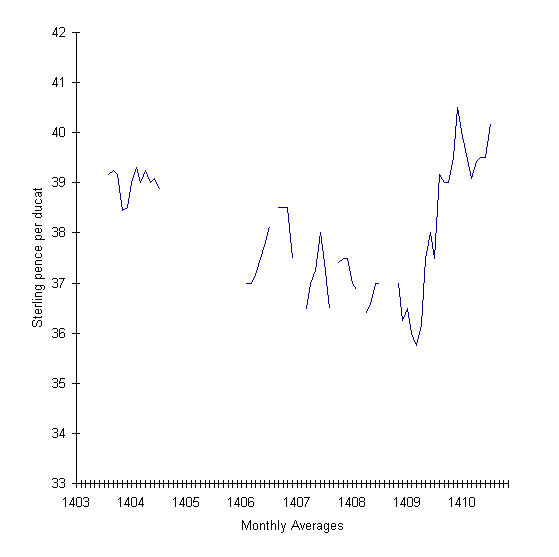- Foreign exchange in Venice during the Datini years
- Paired cities
- The manner in which exchange rates were recorded
- Graphs
What follows is taken directly from Appendix C in Reinhold C. Mueller, The Venetian Money Market: Banks, Panics, and the Public Debt, 1200-1500 (Baltimore, 1997). Page references and the like have been omitted but otherwise the material is essentially as presented by Professor Mueller. Johns Hopkins University Press holds the copyright to this material and it should be used accordingly.
Foreign exchange in Venice during the Datini years, 1383-1410
Exchange rates reacted to demand for specie as well as to demand for credit; and demand was largely foreseeable, according to the rhythm of the activity of the port, as the authors of merchant manuals noted and as is reflected in the commercial correspondence. A detailed year-by-year chronicle of the money market, based on the practically weekly observations of the cambisti operating in Venice, would be useful to underscore those aspects that deviated from the usual seasonal fluctuations [for examples see Chapter 8 of Mueller's book]. At the same time, such a chronicle would be repetitive and tedious. Deviations from the norm, that is, unusual peaks and troughs, can be identified on the graphs [available at this web-site].
The source of the data is the correspondence preserved in the archive of Francesco di Marco Datini. Out of a total of about 150,000 letters extant, some 7,000 were written in Venice by various agents and addressed to branches and agencies in the whole Datini network. The earliest series is that directed to Pisa: some 900 letters, 1383-1402 (buste 548-550); the most important series consists of letters directed to Florence (some 2,100), which begin in 1386, become rare in 1405, and stop altogether in 1407 (buste 709-715); the correspondence with Barcelona (some 1,400) letters begins in 1395 and continues until February 1411, that is, even after Francesco di Marco Datini's death in 1410 (buste 926-929). In gathering data, I perused the first two series completely and the third, which provides particularly complete listings of exchange rates in Venice, only beginning in July 1405. About 400 letters written by Venetians are extant, most of them to Majorca, Barcelona, and Valencia; especially concerned with purchases of raw wool (any study of the wool industry in Venice might well begin here, in identifying interested parties), these letters are surprisingly uninformative on matters of foreign exchange and even of commodity prices. In fact, Venetians preferred working through Florentine commission agents represented in Venice rather than having to deal directly with agents abroad. (A new, complete inventory of the letters is being undertaken under the direction of Bruno Dini and Elena Cecchi.)
I culled quotations or exchanges for 1,229 observation dates, 1383-1411. The rates for Florence are continuous, those of ten other major European banking places much less so. [The observations total 7,326 for the twenty-seven-year period. These are all contained in the Currency Exchange (Mueller) data set at this website.] While transactions were not made on average prices, neither should "market rates" quoted in commercial letters be fetishized: "contractual leverage" was sometimes a factor, so that in practice a client with a better credit rating than his competitor might receive a slightly more advantageous rate on a given day or time of day, for opening, midday, and closing quotations often differed in active markets like Venice.
Paired cities
The relationship between the fluctuation of exchange rates and the availability of specie is particularly clear when one examines the banking places that were situated in geographic proximity. These paired cities, no more than one or two days' postal time apart, are identified in the merchant manual of Giovanni da Uzzano, Pratica della mercatura (ca. 1420); Venice-Bologna, Florence-Pisa, Avignon-Montpellier, Barcelona-Valencia, Bruges-Paris. News of a sharp rise in foreign exchange rates in one city arrived quickly in the other, where the operators immediately responded by sending off specie in order to profit from the rise. Arrival of the specie had the effect of lowering rates, so that in normal equilibrium the rates of the two cities were very close and moved in parallel fashion. This situation is corroborated by the market reports and the rates actually quoted.
The manner in which exchange rates were recorded
By Percentage, Above, At, or Below Par
Pisa, Lucca, Bologna, Rome
The simplest fashion was the relationship of gold coin to gold coin, on the contemporary assumption that one gold ducat (of Venice, of Rome) equaled in value one gold florin (of Florence, of Pisa) wherever it circulated; thus, par was one to one; when ducats were rated above par, the quotation in Venice was given as a percentage "meglio questi"; when they were below par, they were quoted as a percentage "peggio questi." This manner of quoting rates in Venice was used for the markets of Pisa, Lucca, Bologna, and Rome. (It should be noted that Raymond de Roover discovered the manner of quoting rates by percentage only very late; see his "renseignements complémentaires sur le marché monétaire à Bruges au XIVe et au XVe siècle," Handelingen van het Genootschap "Société d'Emulation" te Brugge 109 (1972): 55.)
Actual bills are extant both to and from Pisa, which can serve as examples. On 1 October 1393 Zanobi Gaddi in Venice drew a bill for 20 lire di grossi, payable to Lapo di Messer Lapo in Pisa as 205 gold florins, plus 6s 8d a oro, "at the rate of 2 & 2/3 percent, ducats higher (meglio questi)." An extant Pisan draft on Venice dated 20 March 1396 confirms that the exchange was between gold florins and gold ducats but shows that in this case ducats were lower: the Pisan branch ordered Gaddi to pay Guaspar della Vaiana e Co. in Venice 414 ducats "for 400 gold florins received here from Giovanni Canpolini e Co."; the Pisan florin, that is, was rated 3.5 percent higher than the ducat (at the same time, in Venice, the Pisan florin was rated at 2/3 of 1 percent). (Archivio Datini, Prato, 1143, two drafts on Pisa; 1142 for the draft on Venice; for the corresponding letters to Pisa, see 549; for those to Florence, see 710-11.)
For Pisa, Lucca, and Bologna, all of whose gold currency was largely Florentine, the rates in Venice were generally "meglio questi"; an increase meant an increase in exchange and in interest. As regards Bologna, "paired" with Venice, the rates remained low and ranged generally between 1 and at most 4 percent above par. For Rome, the rates were generally quoted "peggio questi"; thus a rate of 2 percent would mean that for 100 ducats paid out in Venice the remitter had 98 ducats "da camera" in Rome. In the Datini circuit, direct exchange dealings with Rome from Venice were rare; such business was probably handled by the various Alberti and Medici branches.
Pisa's role as a banking place or exchange market, an important role, as seen from the Venice correspondence, was ended when Pisa was subjugated by Florence in October 1406. It was quoted from Venice regularly until August 1405, when it was placed under siege. The last time it was quoted (at 4 percent) was 12 August; on the 22d and then on 7 December 1406, as a tacit comment on the conquest, Pisa was recorded as "H," meaning no business, or no business possible. Pisa seems, however, to return to the status of a banking place of some kind when its rates are again quoted in Venice beginning in August 1409. (Archivio Datini, Prato, 929, Paoluccio to Barcelona (12 August); 715, Paoluccio to Florence (22 August); 929, Commissaria Gaddi to Barcelona (7 December 1406). For the period 1409-10, see 930, letters from Venice to Barcelona.) And one or more of the remittances sent by the agents of Paolo Guinigi of Lucca for the purchase of Venetian government credits between 1412 and 1414 were sent from Pisa [see Chapter 14 of Mueller's book].
Lucca was quoted quite regularly, from 1399 until 1410. Its actual role as a banking place remains questionable, however, if one considers that Paolo Guinigi's agents, in the case just mentioned, never chose to remit directly from Lucca; instead, they shipped gold florins from Lucca to Florence, and sometimes from there to Pisa, from where the assets were then remitted by bill of exchange to Venice. (De Roover, Medici Bank, 237, makes the same point without indicating a date, although the passage seems to be in the context of 1460.) The exchange rates in Venice on Pisa, Bologna, and Lucca are depicted [at this website] in graph 1.
Milan and Genoa
Much more complex were the rates quoted by percentage but between a gold-based money of account (Venice) and a silver-based one (Milan and Genoa). As long as a fixed monetary standard or a nearly stable bimetallic system was in place, the rates quoted varied grosso modo from 1 to 3 percent "Venice higher" [meglio questi], just like the other cities that used percentages expressing a gold-to-gold parity. When extensive debasement of silver ended the stability of the domestic exchange rate in Milan, the foreign exchange rates began to soar in somewhat parallel fashion, thus clearly showing that they were not based on a gold parity at all [see graph 2 at this website].
Here the discussion of specific data is limited to Milan, where the major debasement and then a "monetary earthquake" took place, under the reign of Giangaleazzo Visconti. For Milan, furthermore, we can present the quotations in that market on Venice for the crucial years (1394-1402); those rates, as is clear from graph 2 [at this website], were generally some two points below rates in Venice. High rates denote low demand, low rates high demand. (Luciana Frangioni, Il carteggio milanese dell'Archivio Datini di Prato, 2 vols. (Florence, 1994). The letter of 11 October 1396, which quotes Venice at a very low 1 & 1/4 percent, notes high demand: "c'è al presente fame di danari, come pe' canbi vedete.")
To buy a bill in Venice on Milan meant paying a ducat in Venice in order to receive a Milanese ducat at usance (about fifteen days). Although the rate was quoted as a simple percentage over par, the ducat in Venice was paid in lire di grossi a oro and generally in bank money, whereas the ducat in Milan was paid according to its quotation in silver-based lire imperiali. When the money-of-account system in Milan was still stable at 1 ducat = 32 soldi imperiali, parity with Venice in money of account was 2 Soldi di grossi a oro = 32 soldi imperiali. While Milan was not quoted often in the years 1384-94, the rates moved between 1 and 3 percent. A progressive debasement was undertaken as part of war finance by Giangaleazzo beginning in 1395. Domestic exchange rates began to rise, pushing up foreign exchange rates, until the decree of 21 February 1400, as in table 1. (Tommaso Zerbi, Moneta effettiva e moneta di conto nelle fonti contabili di storia economica (Milan, 1955), 77-84; Gigliola Soldi Rondinini, "Politica e teoria monetarie dell'età viscontea," Nuova rivista storica 59 (1975): 298-302; Franca Levarotti, "Scritture finanziarie dell'età sforzesca," in Squarci d'archivio sforzesco: Mostra storica documentaria (Como, 1981), 134, table 2. For 28 March 1400: Federigo Melis, Documenti per la storia economica dei secoli XIII-XVI (Florence, 1972), doc. 21, where the author was confused between the foreign rate (10 percent) and the domestic rate (35 soldi imperiali per ducat). For April-May 1407: Archivio Datini, Prato, b. 807. These rates supplement Peter Spufford, Handbook of Medieval Exchange (London, 1986), 99 [data available at this website under "Currency Exchange (Spufford).)
| Date | Soldi | Index | Venice Quoting Milan (in %) |
|---|---|---|---|
| Before 1395 | 32 | 100 | min. 2-4, max. 5-6 |
| 1395 24 Aug. | 33.2 | 103.75 | same |
| 1396 - | 33 | 103 | 4-5 |
| 1397 - | 34 | 106 | rise 5 to 10 |
| 1398 mid-Feb. | 35 | 109 | 10.5 |
| Mar. | 36 | 112.5 | 11-12 |
| Apr.-Dec. | - | - | 13-17 |
| 1399 Feb. | - | - | 18-21 |
| Apr. | - | - | 25.5-28.5 |
| Oct.-Dec. | rise | - | 29-40 |
| 1400 Jan. | 44 | 137.5 | - |
| mid-Jan. | 47 | 147 | 47 |
| Feb. | 48-49 | 151.6 | - |
| 14 Feb. | - | - | 52 "bocie" |
| 19 Feb. | - | - | 9 |
| 21 Feb.-1 Mar. | 36 | 112.5 | - |
| 28 Mar. | 35 | 109 | 10 |
| late July | 35-34 | 108 | 12 |
| 1405 - | 41 | 128 | 12.5 (1 rate only) |
| 1406 - | 42 | 131 | (no further rates) |
| 1407 21 Apr. | 48.5 | 151.6 | Milan quoting Venice: 25-26 |
| 4-10 May | 49 | 153 | 26-26.5 |
| 1410 | 48 | 150 | - |
While it is not meaningful to index fluctuating exchange rates in Venice, the relative parallelism of the two exchanges is evident. That both series were interconnected is particularly clear from the effects of the decree of 21 February 1400, the thrust of which -the crying down of silver currency by one-third -was known and reported to Venice immediately, although it went into effect on 1 March. The peak of 52 percent in Venice (50 percent in Milan) was reached during an extremely easy market ("larghezza grande" was reported at the time); the comment "bocie" after the rate meant that there was no demand whatsoever on Milan, presumably as a result of the monetary uncertainty reflected in the high rate. The ducal decree aimed at reinstating the value - artificial as it had often been - of 32 soldi imperiali per ducat. The effect in Milan was to lower the value of silver coin and thus also the value in silver-based lire imperiali of gold coin; the immediate effect on the exchange markets of both Milan and Venice was to compensate - or overcompensate - with a sharp drop in rates expressed in percentages. That is clear proof that the exchange rate expressed formally the relationship between two comparable gold coins, of which one, however, was paid in gold-based money of account (the Venetian ducat), the other (the Milanese florin or ducat) in silver-based money of account. (It is thus clear why the anonymous writer of a merchant manual, when he explained the parameters of exchange in Venice, reported that Milan was quoted at 7-8 percent, when the Milanese florin had a value of 60 soldi imperiali (a level reached about 1430). Biblioteca Nazionale, Firenze, cod. Palatino 601, fol. 66.)
Graph 2 [at this website] shows the curves of rates in Milan and Venice often superimposed or with only a slight lag.
Milan is no longer quoted in the Datini correspondence after 1404 in Venice, nor was Venice quoted after 1402 in Milan, for reasons that are not clear. Continued monetary instability in Milan probably hurt that market as a banking place, but Milanese merchants earlier had preferred to deal through the Venetian exchange market and would do so again later. (See Tommaso Zerbi, II mastro a partita doppia di un'azienda mercantile del '300 (Como, 1936), 74-75, with eight bills on Venice, 1395-98, including an example of rechange; also the studies of Patrizia Mainoni, "Un mercante milanese del primo Quattrocento: Marco Serraineri," Nuova rivista storica 59 (1975): 331-77 (the author mistakenly thought the exchange in Milan to be anchored to gold coin [364], and Mercanti lombardi tra Barcellona e Valenza nel basso medioevo (Bologna, 1982). For scattered exchange dealings with Milan by Andrea Barbarigo, see ledger B, fols. 133 (1444) and 179 (1446).)
The situation in Genoa was quite similar to that in Milan. A stable rate of exchange was maintained for much of the fourteenth century between the gold genovino and silver-based soldi di genovini piccoli, at 1 to 25. The domestic rates became unglued about 1397, judging from the foreign rates [see graph 2 at this website], but too few domestic rates have been collected to be able to know just when and how the rise above 25 soldi developed and for what reasons, whether from depreciations or decrees. (Spufford, Handbook, 112, and de Roover, Bruges Money Market, 75. For extant drafts on Genoa bv Zanobi Gaddi in 1385-86 (at rates of 1 & 1/4 and 7/8 percent respectively), see Archivio Datini, Prato, b. 1144; the correspondence with Genoa is not extant, so that it cannot be known just how common it was to find a direct relationship between Florentine cambisti resident in the two maritime and rival cities.) From 1400 to 1404, in particular, foreign exchange rates for Genoa parallel almost perfectly the rates for Milan, which is sufficient proof that, also in this case, the rate between Venice and Genoa, quoted in percentage above par, was between a gold ducat expressed in gold-based money of account and a gold genovino expressed in silver-based money of account.
Florence
Venice usually quoted Florence certain for uncertain: one ducat, expressed in lire di grossi a oro (1 lira = 10 ducats), was worth a variable number of lire affiorino (1 florin = 1.45 lire affiorino, 10 florins = £14 10s affiorino). Parity of 10 gold ducats to 10 gold florins, therefore, was 1 lira di grossi a oro = £14 10s affiorino.
As long as the lira manca, also called lira di grossi manchi (1 lira = 239 grossi) was still in use in Venice, until about the middle of the fourteenth century, however, parity of the ducat to the florin was slightly different: 1 lira manca, worth 9 & 23/24 ducats, = £14 8s 9 & ½d affiorino. (Giulio Mandich, "Per una ricostruzione delle operazioni mercantili e bancarie della compagnia dei Covoni," in Libro giallo della compagnia dei Covoni, ed. Armando Sapori (Milan, 1970.) After midcentury the lira manca disappeared, and the monetary basis for foreign exchange from then on was the lira di grossi complida, of 240 grossi.
There were also complications on the other end. Florentines used as the basis of their lira affiorino, not the full-weight gold florin, but the fiorino di suggello, of slightly less and then of ever diminishing value; the differential between it and full-weight gold florins was called an agio. In the years 1336-40, studied by Giulio Mandich, the agio was about 2 percent, which would have shifted further "par value." ("La prassi delle assegnazioni e delle lettere di pagamento a Venezia nel 1336-1339 (da un libro di conti)," Studi veneziani, n.s., 11 (1986): 15-46.) In practice, rates of exchange made up for the difference by rising with the agio. This explains the rising trend in rates in the years covered by the Datini correspondence, 1383-1411 (when rates ranged between about 15 lire [3,600 denari] and £15 15s [3,780 denari]; [see graph 3 at this website]; in the years 1415-17, covered in de Roover's study of cambium ad Venetias (range: between £15 12s, and 16 lire); and about 1443, when an anonymous merchant manual gives the range in Venice as £15 12s to £16 10s affiorino for 1 lira di grossi. (On the fiorino di suggello and the agio between it and the gold florin, see Richard A. Goldthwaite and Giulio Mandich, Studi sulla moneta fiorentina (secoli XIII-XVI) (Florence, 1994), 52-54 and table 2. See also Raymond de Roover, "Cambium ad Venetias: Contribution to the History of Foreign Exchange," in his Business, Banking, and Economic Thought in Late Medieval and Early Modern Europe, ed. Julius Kirshner (Chicago, 1974), and Biblioteca Nazionale, Firenze, cod. Palatino, 601, fol. 66. It will be recalled that the partnership capital of the Medici branch in Venice, expressed in fiorini affiorino di suggello, also reflected the rising agio [see Chapter 7, table 3 of Mueller's book.]) In 1455-56, rates were given in percentages and ranged 19-21 percent in Florence, 23-23 & ½ percent in Venice. (Archivio di Stato, Florence, Mediceo avanti il Principato, 134/3, Quaderno dei cambi, tavola di Firenze.)
That was the system - certain for uncertain - which Datini's agents in Venice used in reporting to the head office in Florence the rates current on the Rialto. When they wrote to branches and agents in cities whose exchanges were quoted as percentages over par, however, they quoted also Florence in percentage over par. The conversion between the two systems is not difficult. Since par was considered to be 1 lira di grossi = £14 10s affiorino, or 3,480 denari affiorino, the equation is the following:
(3,480 X %) + 3,480/240 = N lire aff.
For example, on 10 December 1394 Gaddi wrote contemporaneously to Pisa that Florence was quoted 6 percent, and to Florence that the rate was £15 7s 6d affiorino, which jibes [(3,480 X .06) + 3,480/240 = 15.37 lire, or £15 7s 3d]. (Archivio Datini, Prato, 550, Gaddi to Pisa, and 710, Gaddi to Florence, at the stated date.)
Bruges and Paris
The exchange relationship between Venice and Bruges involved three different ways of quoting rates, each way specific to a chronological stage of development.
The two bills of 1360 [of which a transcription can be found in Appendix G, documents 1-2 of Mueller's book] themselves involved two approaches: Venice gave Bruges certain, in that a variable number of Venetian denari grossi a oro (of 24 to the ducat) corresponded to one Flemish gold réal, probably already a money of account, similarly subdivided into 24 groats Flemish. In fact, Pegolotti speaks of par as being "a denaro per denaro." (Francesco Balducci Pegolotti, La practica della mercatura, ed. Allan Evans (Cambridge, Mass., 1936), 248; Spufford Handbook, 213.) In the other direction, Bruges quoted the Venetian ducat in deniers tournois, but as a percentage over par (on 13 October 1360 the rate was 28 & 1/4 percent). Mandich [as cited in App. G of Mueller's book] calculated that par in that case was 16.5 gros tournois per ducat.
The second manner was that employed at the time of the Datini firm's operation, about 1380-1410: each city gave the other certain! Bruges quoted Venice in groats Flemish per ducat, while Venice quoted Bruges in grossi a oro per Flemish gold franc (of 33 groats). (R. de Roover recognized this anomaly in "Renseignements," 57. Of course, his Bruges Money Market is the standard work for the Bruges side. Two bills for 1,000 ducats each were drawn by the Hansa merchant Hildebrand Veckinchusen in Bruges on his agent Peter Karbow in October-November 1410, at 40 groats Flemish per ducat. Michail P. Lesnikov, ed., Die Handelsbücher des Hansischen Kaufmannes Veckinchusen, Forschungen zur Mittelaterlichen Geschichte, vol. 19 (Berlin, 1973), 352-53.)
If we base ourselves on grossi as fractions of the ducat and on groats as fractions of the gold franc (a money of account), the calculations become simpler. A rate of 22 grossi per franc in Venice means 22/24 ducat (or 0.916 ducat) = 33 groats flemish; or, turning it into certain, 1 ducat = 0.916 X 33, that is, 30.228 groats. That figure then becomes perfectly comparable to the return rate Bruges-Venice of, say, 35 groats Flemish per Venetian ducat. And rates in Bruges were regularly higher than those in Venice. A decrease in the number of Venetian grossi per franc meant an increase in exchange rate and thus in the interest rate, which is how the mirror-image oscillations in graph 4 [at this website] are to be interpreted. In this graph de Roover's rates for Bruges quoting Venice have been added to the Venetian series quoting Bruges.
The third manner, which must have been introduced around 1420 and which lasted as long as Bruges remained a banking place, has Bruges giving certain to Venice, so that in both markets rates were quoted as a variable number of Flemish groats per Venetian ducat. From this point on, rates in Venice were almost invariably higher than those in Bruges (see Chap. 8, sec. vi, and graph 8.6 of Mueller's book; also see De Roover, Medici Bank, 116-22.)
Here again we have a gold-based money of account over against a silver-based one, as is clear from the rise in the rate of the ducat in Venice for exchange on Bruges, from 35 groats in 1400 to 50 in 1451 to 60 in 1474.
The system of registering exchange rates in the first two periods was sufficiently complicated as to discourage any extensive operations of rechange or dry exchange between the two cities; the third system, on the other hand, seems to have been made to order so that the Venice-Bruges axis could take over for the traditional Venice-Florence axis, where the one-month "cambium ad Venetias" had reigned supreme for nearly a century. The substitution of a four-month rechange (two months' usance in each direction) for the traditional one-month rechange clearly required streamlining and fixing anew the rules of the game; the manner of quoting rates was changed in order to facilitate making the now more popular longer-term loans - and making a profit on them.
Paris was "paired" with Bruges, that is, their rates were close together, although Paris was clearly second in importance as a banking place; they quoted each other in percentage of par. During the years of operation of the Datini firm, Venice gave Paris certain: a French gold franc was quoted as a variable number of Venetian grossi a oro of account. This means that rates on Paris behaved like those on Bruges in the second stage: a decrease in the number of Venetian grossi per franc meant an increase in exchange rate and thus in the rate of interest. As is obvious [from graph 4 at this website], the curves for both cities move in parallel fashion; any rise in one market or the other was quickly reequilibrated by the movement of specie. In the years 1393-98 the two curves are practically superimposed.
Paris was quoted regularly in the Datini letters from 1392 to 1410. Zanobi Gaddi wrote to Pisa in 1399, "Per Parigi si canbia spesso, e sì per Bruggia" (Archivio Datini, Prato, 550, 11 October 1399) After the English victory at the battle of Agincourt (1415), Paris ceased to be a banking place. (See the overview in Raymond de Roover, "Le marché monétaire a Paris du régne de Philippe le Bel au début du XVe siècle" in Académie des inscriptions et belles-lettres: Comptes rendus (séances of November-December 1968, published 1969, Paris), 548-58.)
Barcelona
Barcelona also "gave certain" to Venice: a variable number of soldi and denari of the lira of Barcelona for one Venetian gold ducat. The range around 1400 was between 15 soldi and 16s 8d per ducat. An example of an actual bill: on 14 June 1398 Bernardo Alberti and Company drew 100 lire di grossi (1,000 ducats) on Barcelona, at 16s 2d per ducat. After two months' usance, the beneficiary was to receive in Barcelona £808 6s 8d Barcelona currency. (Archivio Datini, Prato, 1145bis; in decimals 16.167 X 1,000/20 = 808.3.)
Graph 5 [at this website] provides two curves, one for Venice quoting Barcelona, the other, using data that de Roover published, for Barcelona quoting Venice. It should be noted that the Venice-Barcelona axis was not normally utilized for rechange operations. On the contrary, Venice remitted to Barcelona primarily to pay for raw wool, and the biggest remitters during the Datini years were the wool importers Antonio Contarini, lanaiuolo in his own right, and the partnership of Giorgio Corner and Gabriele Soranzo (the banker), who remitted funds when they gave orders for purchases at each new shearing. Zanobi Gaddi wrote to Pisa on 11 October 1399, "Di qui a Barzalona si canbia rade volte ora, ma qua al Natale questi Viniziani vi voranno rimetere, sichè alora potrete dare le comesioni; ora non c'è se non canbiatori, siatene avisati." As regards usance, he continued: "Fàsi di qui dal dì a 2 mesi, o dì 30 vista, m'al più vogliono 2 mesi a la fata." On the 25th there were already takers. Archivio Datini, Prato, 550. That Barcelona rarely drew on or remitted to Venice can be seen from the fact that Venice is not mentioned once among the thirty-eight bills contracted by the Datini branch in Barcelona in the first four months Of 1396; see the table in Enrico Bensa, Francesco di Marco da Prato: Notizie e documenti sulla mercatura italiana del sec. XIV (Milan, 1928), 466.) The Medici continued over the following decades to sell drafts in Venice to importers of wool and saffron from Spain. (De Roover, Medici Bank, 245.) Barcelona as an exchange market, on the other hand, dealt with the West: with Montpellier, with Genoa, but especially with Bruges. (Archivio Datini, Prato, 823 (1395-96) and 841 (1398-99), account books devoted exclusively to the bill trade in Barcelona.) And there was clearly a triangular relationship, Barcelona-Bruges-Venice, which de Roover always maintained was a commonly used route for settling international balances. (He always held that "northwest Europe" had an unfavorable balance of trade in relation to Italy; see "La balance commerciale entre les Pays-Bas e l'Italie au quinzième siècle,"Revue belge 37 (1959): 374-86, and Bruges Money Market, 43-46. The thesis was criticized by W B. Watson, "The Structure of the Florentine Galley Trade with Flanders and England in the Fifteenth Century: Some Evidence about Profits and the Balance of Trade," Revue belge, 39 (1961) and 40 (1962), and Edmund B. Fryde, "Anglo-Italian Commerce in the Fifteenth Century: Some Evidence about Profits and the Balance of Trade," Revue belge 50 (1972): 345-55.) Finally, the Venice-Barcelona axis interested cambisti involved in arbitrage and triangular relationships with Valencia, as we saw above [Chap. 8 of Mueller's book] in the example provided by Benedetto Cotrugli.
London
Venice quoted London certain for uncertain: a variable number of sterling pence per gold ducat. The range in this period was about 38 to 42 pence per ducat; around 1450 the range was 45 to 47 pence [see Chap. 8, graph 8.7 of Mueller's book]. Rates were almost invariably higher in Venice than in London, which made possible the longest loan on a single rechange, one of six months' duration (three months' usance in each direction). See graph 6 [at this website].
Other Cities Mentioned
Besides the eleven major cities discussed above, very occasionally rates for other cites, such as Verona, Perugia, and Viterbo, were mentioned in the Datini correspondence. These were not "banking places" and they were quoted only in extraordinary circumstances, such as when troops had to be paid in Verona in January 1389. Similarly exceptional were remittances to Ferrara (during the Chioggia war for the purchase of wheat), Palermo, and Avignon. (Archivio di Stato, Venice, Procuratori di San Marco, Citra, b. 141, account book of Tommaso Talenti, fol. 19r: cash was paid to Giovanni Portinari in Venice, "per scrittura di Bartolomeo da Carixe" (an immigrant from Ferrara, recently established as a banker on the Rialto), to remit 600 ducats to Ludovico Avvenati in Ferrara (6 June 1380). Regarding Palermo and Avignon, see the information sent to Florence by Gaddi on 21 July and 25 October 1386 (Archivio Datini, Prato, 709); for Perugia, see Piaciti's letter of 29 April 1402 (Archivio Datini, Prato, 714).
Graphs
Graphs 1-6 give the fluctuations of exchange on the basis of monthly averages of the data. In graph 3, concerning Florence, one can clearly note a rising trend, the result largely of the increasing agio of the fiorino di suggello against the fiorino d'oro.
Graph 1 - Pisa, Bologna, and Lucca
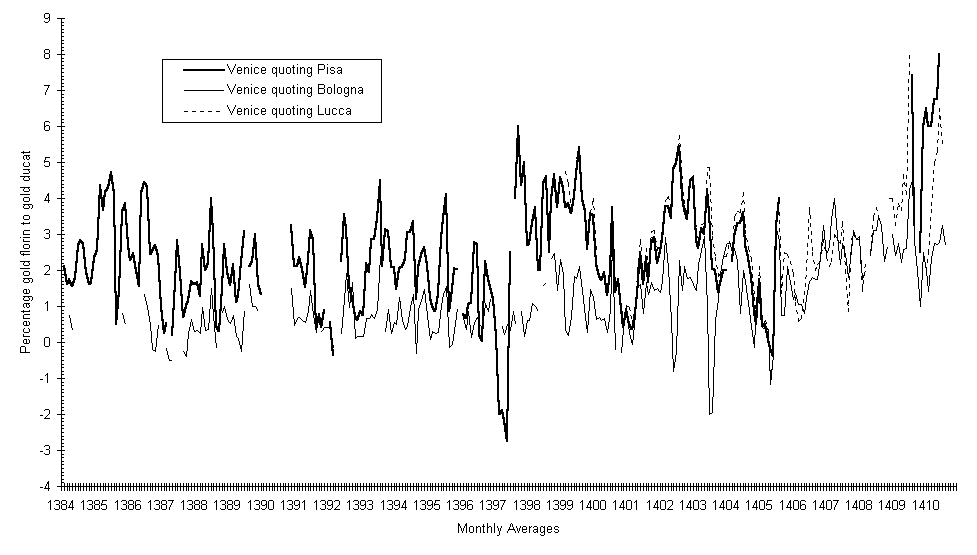
Graph 2 - Milan and Genoa
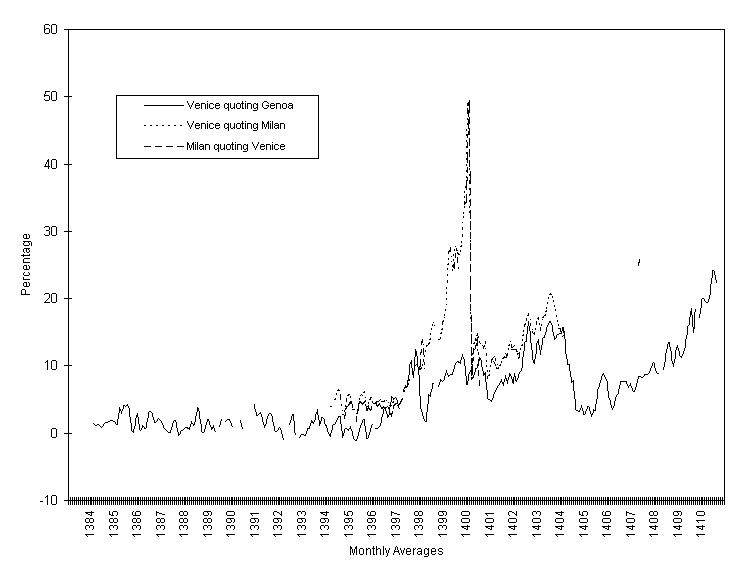
Graph 3 - Florence
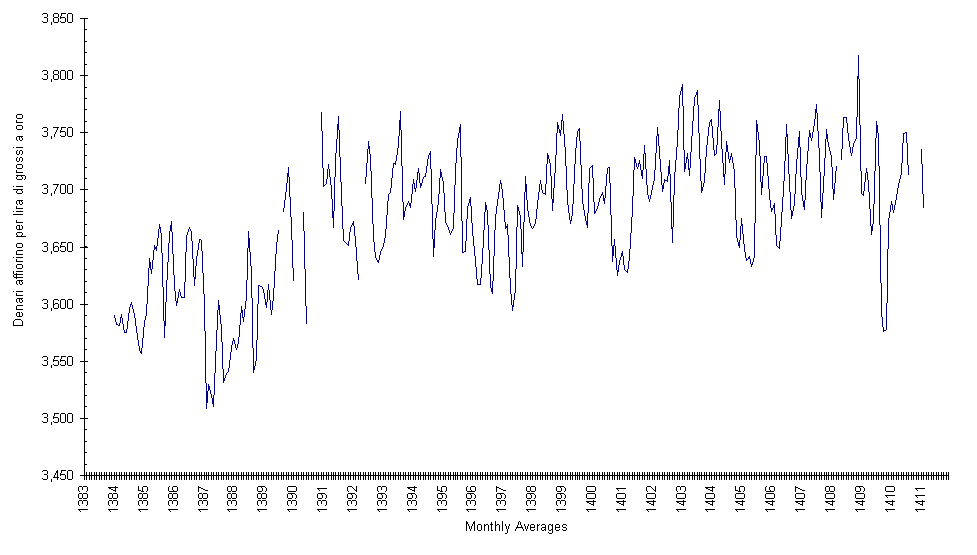
Graph 4 - Bruges and Paris
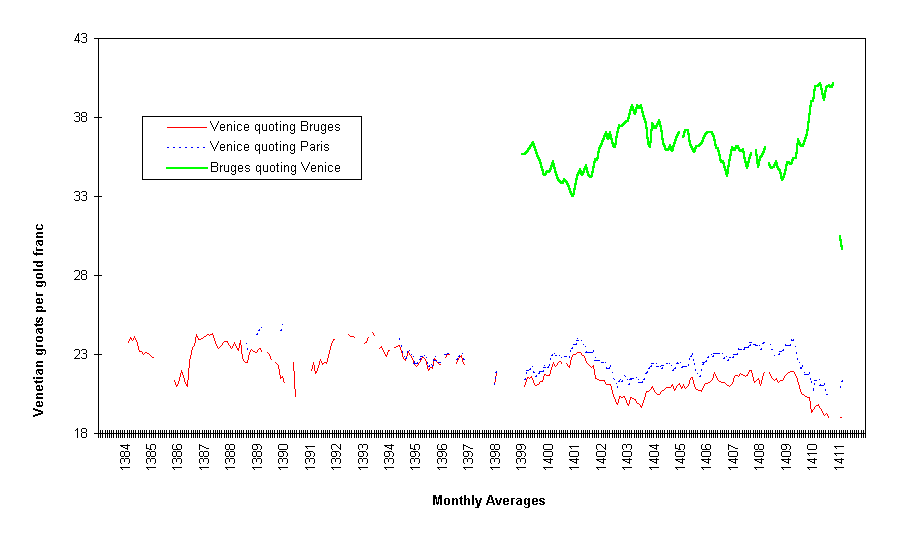
Graph 5 - Barcelona
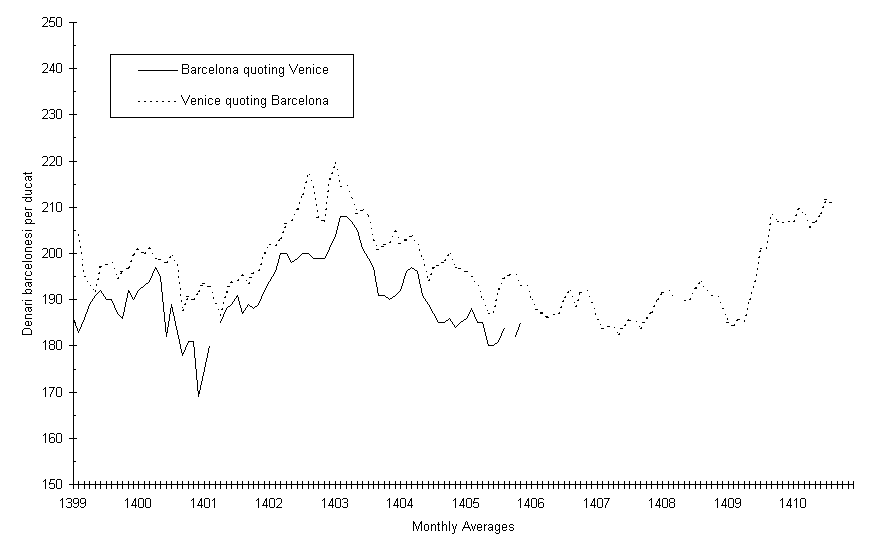
Graph 6 - London
